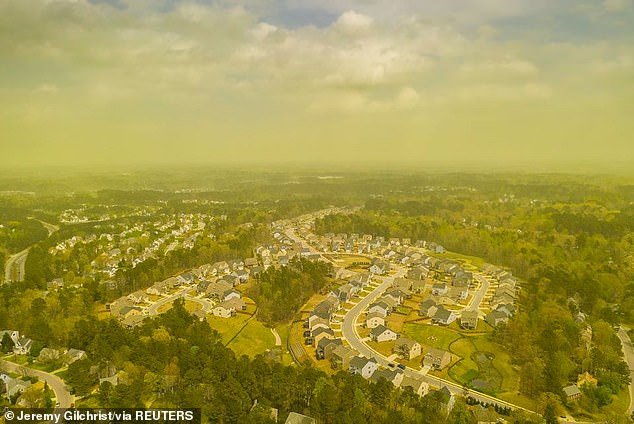As warming spring temperatures encourage Americans to gather outside, the air can be particularly brutal for those who suffer from allergies.
Elevated pollen counts can cause a slew of symptoms including itching, watering eyes; runny noses; sneezing; and coughing.
Meteorologists and allergists say that, with climate change, allergies are getting worse and worse every year – with 2021 shaping up to be the worst year yet.
This means not only longer pollen seasons, but also more intense seasons.
Allergy seasons that typically started in April, are now beginning as early as the first week of March or last week of February, doctors reveal.
What’s more, a recent report from the Asthma and Allergy Foundation of America found that across the country – from Scranton, Pennsylvania to Richmond, Virginia to Wichita, Kansas – cities are reporting worsening seasonal allergies.
Meanwhile, most scientists have stopped the labor-intensive work of pollen counting, so there are very few researchers at the 90 counting stations across the country who are scrambling to discover if there is more pollen than usual in the air.
Experts say allergies are getting worse every year, especially due to pollen, with 8% of American adults suffering from hay fever as a result of pollen allergies. Pictured: Yellow pollen haze tints the sky yellow in Durham, North Carolina, April 2019

There fewer than 90 certified reporting stations in the U.S. from which allergists can count the amount of pollen in the air. Pictured: Dr Donald Dvorin, the Philadelphia region’s only certified pollen counter, looks at pollen under a microscope courtesy of WHYY News
Allergies occur when the body’s immune system views a substance as harmful and overreacts to it.
Reactions may be mildly annoying from sneezing and watery eyes to life-threatening such as anaphylactic shock, which is when blood pressure suddenly drops and airways narrow, preventing someone from breathing normally.
Having a pollen allergy means you experience an allergic reaction to a powder found on flowering plants.
Because pollen is microscopic in size – less than 0.007 inches – it can travel far distances and is easily inhaled, getting deep into the lungs.
Grass and tree pollen typically is released between April and May while pollen from weeds, like ragweed, comes in June and July.
According to the American Academy of Allergy, Asthma and Immunology, about eight percent of U.S. adults aged 18 and over suffer from hay fever, which is the allergic reaction to pollen.
However, scientists say there is no doubt that climate change has made pollen season longer and worse in the U.S.
This occurs in two ways. Firstly, as Americans burn more fossil fuels, the amount of carbon dioxide (CO2) in the atmosphere increases.
‘When CO2 goes up, plants tend to grow a little bigger,’ Dr William Anderegg, an assistant professor of biology at the University of Utah, told Vox.
‘They tend to put out more flowers as a fraction of their mass, and individual flowers tend to have actually more pollen on them.’
This leads to plants producing more pollen, resulting in more seeds that will mean more plants next season.
In addition, as the planet heats up due to more carbon dioxide, plants also heat up, which means winter temperatures are not as cold and spring comes earlier, reported Vox.
‘As spring heats up, all of these life cycle events, including pollen seasons, tend to shift earlier,’ Anderegg said.
But it’s hard to tell how much pollen is in the air.
According to the National Allergy Bureau, there are fewer than 90 certified reporting stations in the U.S., well behind several countries including Japan, Germany and France.
‘Pollen observations are sparse, sporadic, not standardized, often hard to come by,’ Dr Fiona Lo, a postdoctoral researcher in the Department of Environmental and Occupational Health Sciences at the University of Washington, told The Philadelphia Inquirer.
‘Among the pollen researchers, it’s well-known that the U.S. pollen data is insufficient.
Pollen counting currently requires volunteers spending hours collecting and analyzing samples, which can be tedious.
The labor-intensive process means many allergists abandon the practice to spend more time doing other duties, like teaching, reported The Inquirer.
‘Very, very few allergists want to get into this because of the time factor,’ Dr Donald Dvorin, the Philadelphia region’s only certified pollen counter, told the newspaper.
A recent study found that the pollen season has increased by 20 days in North America and pollen concentration has risen by 21 percent from 1990 to 2018.
Lo said several in the allergy community want the way pollen is counted to improve but lack the resources to do so.
